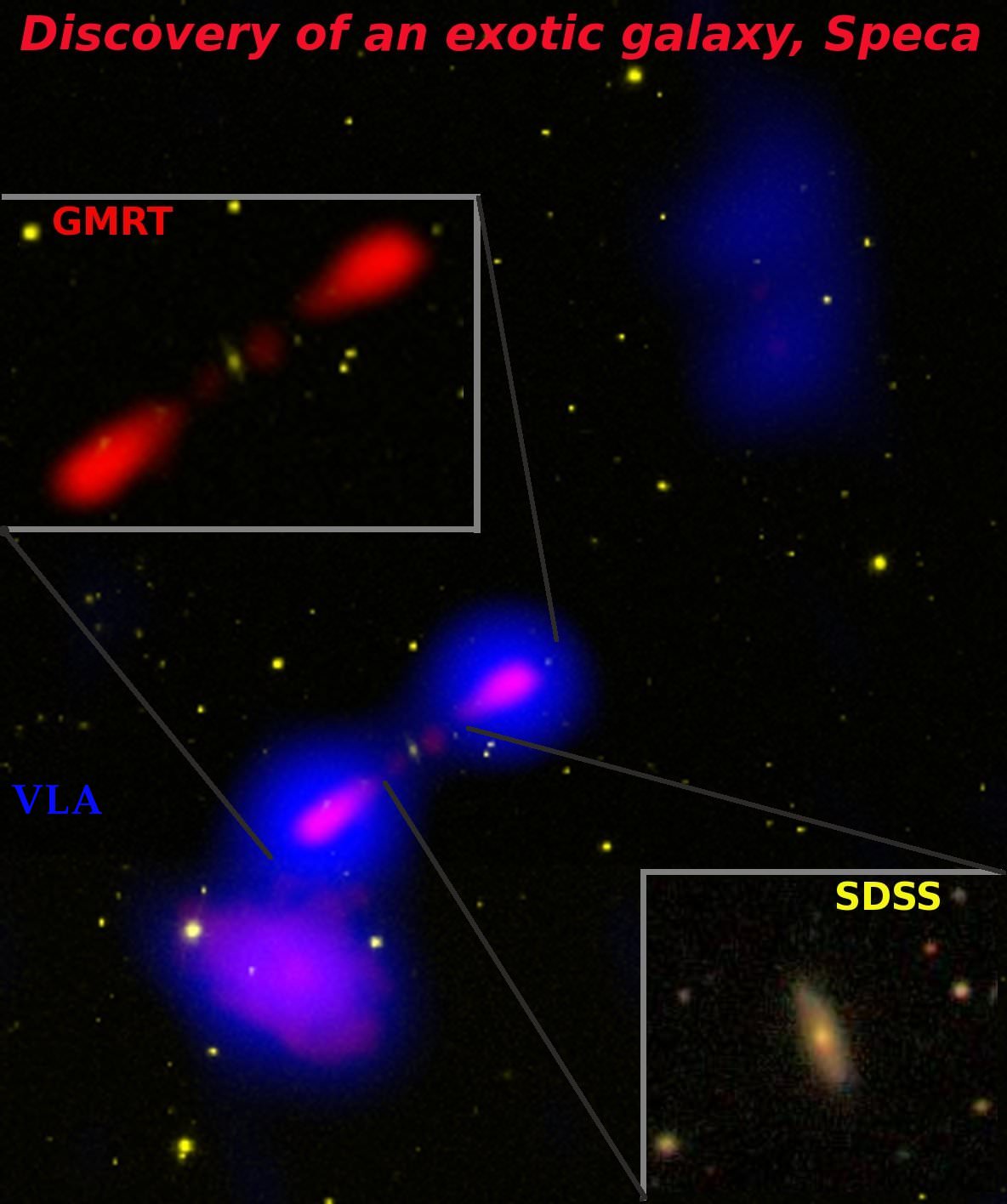[/caption]
Its name is SPECA – a Spiral-host Episodic radio galaxy tracing Cluster Accretion. That’s certainly a mouthful of words for this unusual galaxy, but there’s a lot more going on here than just its name. “This is probably the most exotic galaxy with a black hole, ever seen. It is like a ‘missing-link’ between present day and past galaxies. It has the potential to teach us new lessons about how galaxies and clusters of galaxies formed in the early Universe,” said Ananda Hota, of the Academia Sinica Institute of Astronomy and Astrophysics (ASIAA), in Taiwan and who discovered this exotic galaxy.
Located about 1.7 billion light-years from Earth, Speca is a radio source that contains a central supermassive black hole. As we have learned, galaxies of this type produce relativistic “jets” which are responsible for being bright at the radio frequencies, but that’s not all they create. While radio galaxies are generally elliptical, Speca is a spiral – reason behind is really unclear. As the relativistic jets surge with time, they create lobes of sub-atomic material at the outer edges which fan out as the material slows down… and Speca is one of only two galaxies so far discovered to show this type of recurrent jet activity. Normally it occurs once – and rarely twice – but here it has happened three times! We are looking at a unique opportunity to unravel the mysteries of the beginning phase of a black hole jet.
“Both elliptical and spiral galaxies have black holes, but Speca and another galaxy have been seen to produce large jets. It is also one of only two galaxies to show that such activity occurred in three separate episodes.” explains Sandeep Sirothia of NCRA-TIFR. “The reason behind this on-off activity of the black hole to produce jets is unknown. Such activities have not been reported earlier in spiral galaxies, which makes this new galaxy unique. It will help us learn new theories or change existing ones. We are now following the object and trying to analyse the activities.”
Dr. Hota and an international team of scientists reached their first conclusions while studying combined data from the visible-light Sloan Digital Sky Survey (SDSS) and the FIRST survey done with the Very Large Array (VLA) radio telescope. Here they discovered an unusually high rate of star formation where there should be none and they then confirmed their findings with ultraviolet data from NASA’s GALEX space telescope. Then the team dug even deeper with radio information obtained from the NRAO VLA Sky Survey (NVSS). At several hundred million years old, these outer lobes should be beyond their reproductive years… Yet, that wasn’t all. GMRT images displayed yet another, tiny lobe located just outside the stars at the edge of Speca in plasma that is just a few million years old.
“We think these old, relic lobes have been ‘re-lighted’ by shock waves from rapidly-moving material falling into the cluster of galaxies as the cluster continues to accrete matter,” said Ananda. “All these phenomena combined in one galaxy make Speca and its neighbours a valuable laboratory for studying how galaxies and clusters evolved billions of years ago.”
As you watch the above galaxy merger simulation created by Tiziana Di Matteo, Volker Springel, and Lars Hernquist, you are taking part in a visualization of two galaxies combining which both have central supermassive black holes and the gas distribution only. As they merge, you time travel over two billion years where the brightest hues indicate density while color denotes temperature. Such explosive process for the loss of gas is needed to understand how two colliding star-forming spiral galaxies can create an elliptical galaxy… a galaxy left with no fuel for future star formation. Outflow from the supernovae and central monster blackholes are the prime drivers of this galaxy evolution.
“Similarly, superfast jets from black holes are supposed to remove a large fraction of gas from a galaxy and stop further star formation. If the galaxy is gas-rich in the central region, and as the jet direction changes with time, it can have an adverse effect on the star formation history of a galaxy. Speca may have once been part of such a scenario. Where multiple jets have kicked out spiral arms from the galaxy. To understand such a process Dr Hota’s team has recently investigated NGC 3801 which has very young jet in very early-phase of hitting the host galaxy. Dust/PAH, HI and CO emission shows an extremely warped gas disk. HST data clearly showa outflow of heated-gas. This gas loss, as visualised in the video, has possibly caused the decline of star formation. However, the biggest blow from the monster’s jets are about to give the knock-down punch the galaxy.
“It seems, we observe this galaxy at a rare stage of its evolutionary sequence where post-merger star formation has already declined and new powerful jet feedback is about to affect the gaseous star forming outer disk within the next 10 million years to further transform it into a red-and-dead early-type galaxy.” Dr. Hota says.
The causes behind why present day radio galaxies do not contain a young star forming disks are not clear. Speca and NGC 3801 are ideal laboratories to understand black hole galaxy co-evolution processes.
Original Research Paper: Caught in the act: A post-merger starforming early-type galaxy with AGN-jet feedback. For Further Reading: Various press releases and news on the discovery of Speca. This article has been changed slightly from its original publication to reflect more information from Dr. Hota.


